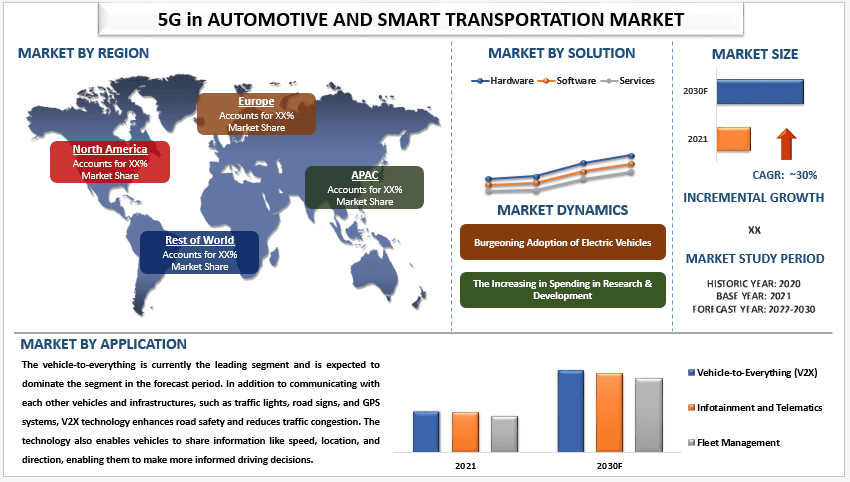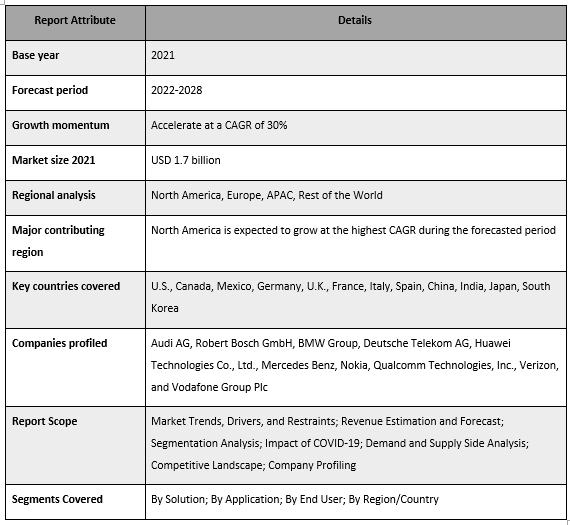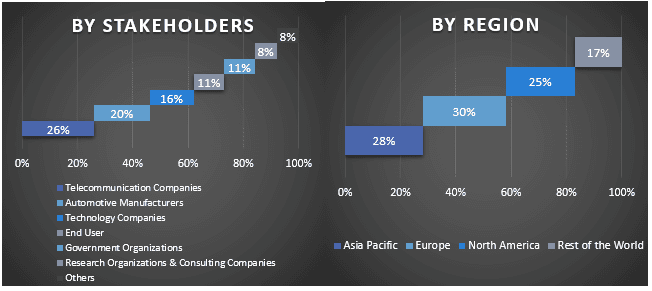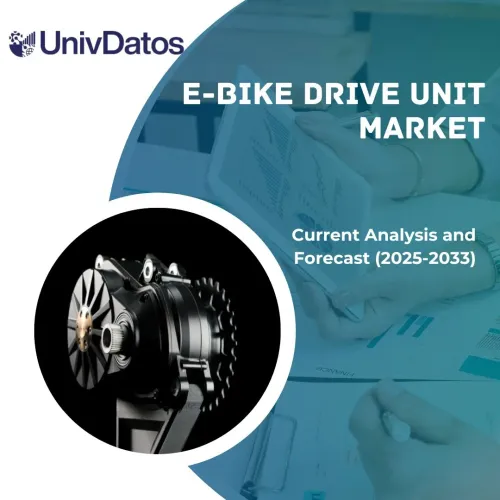- Home
- About Us
- Industry
- Services
- Reading
- Contact Us
5G in Automotive and Smart Transportation Market – Global Industry Analysis, Size, Share, Growth & Forecast (2022-2030)
Emphasis on Solution (Hardware, Software, Services); Application (Vehicle-to-Everything (V2X), Infotainment and Telematics, Fleet Management); End User (Automotive, Defense, Transportation Infrastructure, Warehousing & Logistics, Public Safety, and Others); and Region/Country

The 5G in Automotive and Transportation Market was valued at USD 1.7 billion in 2021 & are expected to grow at a CAGR of 30% from 2022-2030.Owing to the burgeoning adoption of electric vehicles globally. An electric vehicle sometimes called Battery Electric Vehicle (BEV) has an electric motor as an engine instead of a combustion engine, which is charged by a battery or other energy source. The electric vehicle has the potential to propel the 5G in the automotive and smart transportation market by enabling communication technologies, and connectivity features. These vehicles consist of a large number of sensors, cameras, and communication modules which required fast internet connectivity and low latency for better operation, which is provided by 5G technology. Moreover, the 5G technology provides real-time communications between vehicles, infrastructure, and the cloud, this connectivity facilitated the applications such as ADAS, V2V, and V2I communication. Additionally, with the connectivity of 5G technology electric vehicles communicate with traffic management systems in real-time, in which vehicles have access to real-time road conditions and enhanced route suggestions from the cloud by optimizing their navigation system. Hence, the city has a more efficient traffic system and reduces congestion, and provides better safety.
For instance, in 2023, according to the report published by EV volumes, the global sale of electric vehicles of 10.5 million in 2022, an increase of +55 % compared to 2021. Therefore, the growing adoption of electric vehicles propels the demand for 5G in the automotive and smart transportation market in the coming years.
Some of the major players operating in the market include Audi AG, Robert Bosch GmbH, BMW Group, Deutsche Telekom AG, Huawei Technologies Co., Ltd., Mercedes Benz, Nokia, Qualcomm Technologies, Inc., Verizon, and Vodafone Group Plc. Several M&As along with partnerships have been undertaken by these players to facilitate customers with hi-tech and innovative products/technologies.
Insights Presented in the Report
“Amongst solutions, the hardware segment held a dominating share of the market in 2021”
Based on solution, the market is segmented into hardware, software, and services. The hardware category is currently dominating the market and is expected to see the same trend in the forecast period. The major factor attributing to the growth of the segment is the deployment of 5G networks all over the world which requires significant investments in infrastructure such as network equipment, small cells, and antennas. The segment consists of various components such as user equipment, radio access points, and base stations which are essential for the deployment of 5G networks. Moreover, due to increasing demand for high-speed connectivity and the need for efficient transportation have increased the demand for the hardware segment in 5G in the automotive and smart transportation market in coming years.
“Amongst applications, the vehicle-to-everything held the leading segment of the market in 2021”
Based on application, the market is segmented into vehicle-to-everything, infotainment and telematics, and fleet management. The vehicle-to-everything is currently the leading segment and is expected to dominate the segment in the forecast period. In addition to communicating with each other vehicles and infrastructures, such as traffic lights, road signs, and GPS systems, V2X technology enhances road safety and reduces traffic congestion. The technology also enables vehicles to share information like speed, location, and direction, enabling them to make more informed driving decisions.
“North America dominated the 5G in automotive and smart transportation market in 2021”
The North America region is projected to be the fastest growing region in the forecast period as the region is going through the heavy automotive expanding industry with major big giants such as General Motors, Tesla, and others. The region is the IT hub that continuously develops new and advanced technologies to support the incremental growth of the telecommunication industry by providing funds to stand market. For instance, in April 2023, according to the report published by The Wall Street Journal, reports that the US government started planning for the next generation of wireless communications, known as 6G. The Federal Communications Commission (FCC) has initiated a process to free up spectrum for 6G and has set a goal of having a plan in place by 2023. The FCC has also announced a USD 200 million fund to support the development of 6G technology in the US.
5G in Automotive and Smart Transportation Market Report Coverage

Reasons to buy this report:
- The study includes market sizing and forecasting analysis validated by authenticated key industry experts.
- The report presents a quick review of overall industry performance at one glance.
- The report covers an in-depth analysis of prominent industry peers with a primary focus on key business financials, product portfolios, expansion strategies, and recent developments.
- Detailed examination of drivers, restraints, key trends, and opportunities prevailing in the industry.
- The study comprehensively covers the market across different segments.
- Deep dive regional level analysis of the industry.
Customization Options:
The global 5G in automotive and smart transportation market can further be customized as per the requirement or any other market segment. Besides this, UMI understands that you may have your own business needs, hence feel free to connect with us to get a report that completely suits your requirements.
Table of Content
Research Methodology for the 5G in Automotive and Smart Transportation Market Analysis (2022-2030)
Analyzing the historical market, estimating the current market, and forecasting the future market of the global 5G in automotive and smart transportation market were the three major steps undertaken to create and analyze the adoption of 5G in automotive and smart transportation in major regions globally. Exhaustive secondary research was conducted to collect the historical market numbers and estimate the current market size. Secondly, to validate these insights, numerous findings and assumptions were taken into consideration. Moreover, exhaustive primary interviews were also conducted, with industry experts across the value chain of the global 5G in automotive and smart transportation market. Post assumption and validation of market numbers through primary interviews, we employed a top-down/bottom-up approach to forecasting the complete market size. Thereafter, market breakdown and data triangulation methods were adopted to estimate and analyze the market size of segments and sub-segments of the industry pertains to. Detailed methodology is explained below:
Analysis of Historical Market Size
Step 1: In-Depth Study of Secondary Sources:
Detail secondary study was conducted to obtain the historical market size of the 5G in automotive and smart transportation market through company internal sources such as annual reports & financial statements, performance presentations, press releases, etc., and external sources including journals, news & articles, government publications, competitor publications, sector reports, third-party database, and other credible publications.
Step 2: Market Segmentation:
After obtaining the historical market size of the 5G in automotive and smart transportation market, we conducted a detailed secondary analysis to gather historical market insights and share for different segments & sub-segments for major regions. Major segments are included in the report as service type, type, vehicle type, distance, and platform mode. Further country-level analyses were conducted to evaluate the overall adoption of testing models in that region.
Step 3: Factor Analysis:
After acquiring the historical market size of different segments and sub-segments, we conducted a detailed factor analysis to estimate the current market size of the 5G in automotive and smart transportation market. Further, we conducted factor analysis using dependent and independent variables such as service type, type, propulsion type, distance, and platform mode of the 5G in automotive and smart transportation market. A thorough analysis was conducted for demand and supply-side scenarios considering top partnerships, mergers and acquisitions, business expansion, and product launches in the 5G in automotive and smart transportation market sector across the globe.
Current Market Size Estimate & Forecast
Current Market Sizing: Based on actionable insights from the above 3 steps, we arrived at the current market size, key players in the global 5G in automotive and smart transportation market, and market shares of the segments. All the required percentage shares split and market breakdowns were determined using the above-mentioned secondary approach and were verified through primary interviews.
Estimation & Forecasting: For market estimation and forecast, weights were assigned to different factors including drivers & trends, restraints, and opportunities available for the stakeholders. After analyzing these factors, relevant forecasting techniques i.e., the top-down/bottom-up approach were applied to arrive at the market forecast for 2030 for different segments and sub-segments across the major markets globally. The research methodology adopted to estimate the market size encompasses:
- The industry’s market size, in terms of revenue (USD) and the adoption rate of the 5G in automotive and smart transportation market across the major markets domestically
- All percentage shares, splits, and breakdowns of market segments and sub-segments
- Key players in the global 5G in automotive and smart transportation market in terms of products offered. Also, the growth strategies adopted by these players to compete in the fast-growing market
Market Size and Share Validation
Primary Research: In-depth interviews were conducted with the Key Opinion Leaders (KOLs) including Top Level Executives (CXO/VPs, Sales Head, Marketing Head, Operational Head, Regional Head, Country Head, etc.) across major regions. Primary research findings were then summarized, and statistical analysis was performed to prove the stated hypothesis. Inputs from primary research were consolidated with secondary findings, hence turning information into actionable insights.
Split of Primary Participants in Different Regions

Market Engineering
The data triangulation technique was employed to complete the overall market estimation and to arrive at precise statistical numbers for each segment and sub-segment of the global 5G in automotive and smart transportation market. data was split into several segments & sub-segments post studying various parameters and trends in the areas of the solution, application, and end-user in the global 5G in automotive and smart transportation market.
The main objective of the Global 5G in Automotive and Smart Transportation Market Study
The current & future market trends of the global 5G in automotive and smart transportation market were pinpointed in the study. Investors can gain strategic insights to base their discretion for investments on the qualitative and quantitative analysis performed in the study. Current and future market trends determined the overall attractiveness of the market at a regional level, providing a platform for the industrial participant to exploit the untapped market to benefit from a first-mover advantage. Other quantitative goals of the studies include:
- Analyze the current and forecast market size of the 5G in automotive and smart transportation market in terms of value (USD). Also, analyze the current and forecast market size of different segments and sub-segments
- Segments in the study include areas of the solution, application, and end-user
- Define and analysis of the regulatory framework for the 5G in automotive and smart transportation industry
- Analyze the value chain involved with the presence of various intermediaries, along with analyzing customer and competitor behaviors of the industry
- Analyze the current and forecast market size of the 5G in automotive and smart transportation market for the major region
- Major countries of regions studied in the report include Asia Pacific, Europe, North America, and the Rest of the World
- Company profiles of the 5G in automotive and smart transportation market and the growth strategies adopted by the market players to sustain in the fast-growing market
- Deep dive regional level analysis of the industry
Related Reports
Customers who bought this item also bought










